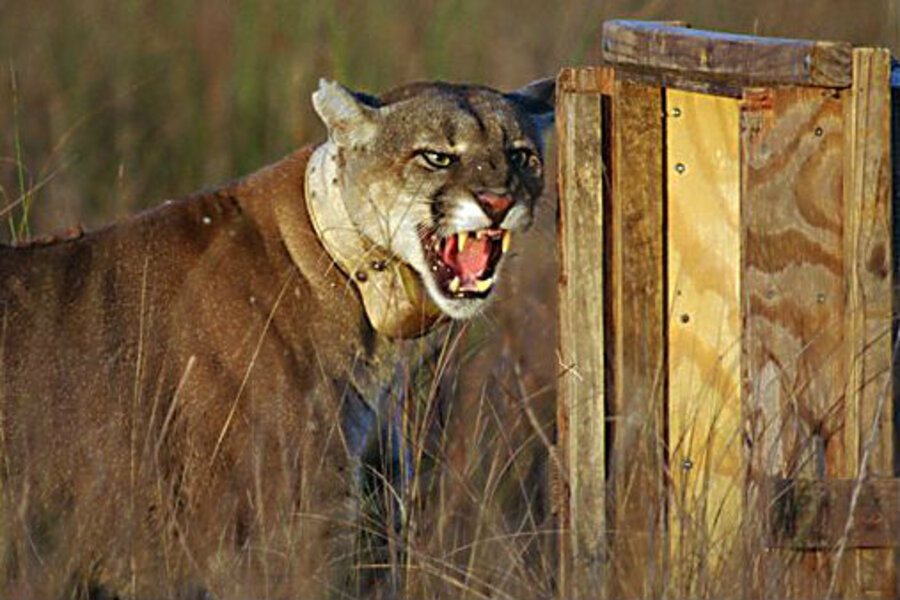Rebounding Florida panther population killing ranchers' calves, says study
Loading...
| Immokalee, Fla.
Since Florida's frontier days when cattlemen drove their herds through the state's vast fields and forests, ranchers and native panthers have been natural enemies.
The ranchers seek to nurture and protect their calves, while the panthers see them as prey.
Human development won the battle, driving the large, tawny, cats to the brink of extinction before successful efforts to restore them began decades ago.
But with Florida's panther population recovering, some farmers complain the protected 6-to-7-foot long predators are once again killing their calves.
Now, university research supports that claim, at least in one part of southwest Florida.
A University of Florida researcher hired by federal wildlife officials has found that panthers are killing calves in an area where the predatory felines are thriving. Her study, the first to quantify the kills and losses, was given to The Associated Press exclusively.
The research marks the first step toward the U.S. Fish and Wildlife Service considering a program that would pay ranchers for preserving acres of panther habitat, instead of undertaking the impossible task of verifying every kill.
"Ranchers will tell you that they suspected panthers were killing their calves, although no one knows how many they're losing," said Caitlin Jacobs, the university researcher who staked out a ranch for the better part of two years. "It's hard to find the calves — when panthers kill they drag the prey into the forest and cover it with brush to hide them from scavengers."
The problem began to draw the attention of state and federal wildlife officials about four years ago, after third-generation Florida rancher Liesa Priddy, owner of the 9,300-acre JB Ranch near Immokalee, became suspicious when a new calf vanished.
"My first calf went missing shortly after being born," said Priddy, who is also a member of the Florida Fish and Wildlife Conservation Commission. "I couldn't find remnants of a body or anything else. She just totally disappeared."
Ranchers had been telling federal and state wildlife officials about the problem for years, but lacked scientific evidence. Calves are also commonly killed by coyotes, vultures and even bears.
In the past, ranchers simply would have shot the panthers, but because the state's 100 to 180 panthers are legally protected under the Endangered Species Act, they have few options.
Priddy had a local outdoorsman stake out her pasture with night-vision goggles. That night, a panther took a calf and they found the carcass, Priddy said.
She called out a state biologist, who confirmed it was a panther kill and began the research to find out how pervasive the issue had become.
"We started to hear more from the ranching community as a whole that this was a problem that we need to address," said Kevin Godsea, project leader of the Florida Panther National Wildlife Refuge. "Since then we've done some investigating. We didn't know how big the problem was."
The researchers targeted two ranches and tagged 400 calves on each. They found that JB Ranch, which has nearby forests where panthers can hide, lost 10 calves, or about 5 percent. A beef cow can go for around $1,000. A lost heifer can cost future profits from breeding more cows.
The other ranch lost only one calf to panthers over that time.
The study's results are set to be released later this year. The information can help wildlife managers move forward on ideas for compensating ranchers.
"We don't feel as landowners and ranchers that we should have to bear the cost of protecting an endangered species," Priddy said. "It's a public cost that should be shared by everyone."
Right now, small ranchers with less than 100 head of cattle can apply for compensation from two nonprofits: Defenders of Wildlife and Conservancy of Southwest Florida.
But those programs aren't used by bigger ranches, Godsea said, and don't have the resources to address the larger problem.
"Without good science, we can't make good policy or management decisions," Godsea said. "(This) research is absolutely essential."
But any compensation plan must be designed to prevent false claims, says Jennifer Hecker, director of natural resource policy for the Conservancy of Southwest Florida.
"The devil's in the details," Hecker said.
Ironically, panther experts say Florida's ranches have helped the panther somewhat by keeping large tracts of land largely development free.
"If there weren't ranches in Florida, there'd be no panthers," said UF's Jacobs. "The ranchers have kept the middle of Florida development free. They've maintained this landscape the panthers will need to ever be to be considered recovered."





